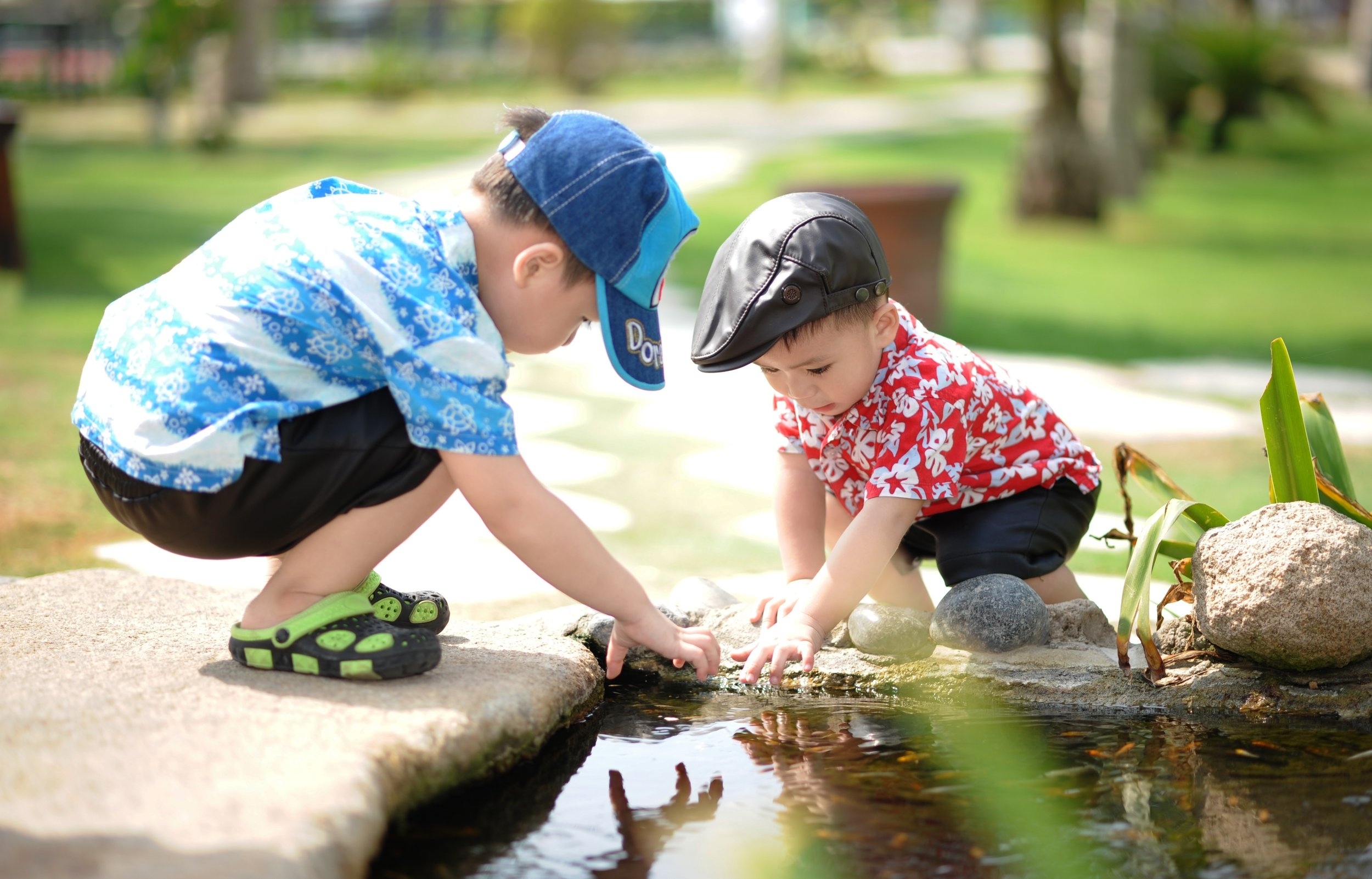A preschool teacher recently wrote to me and asked,
“Do you have any suggestions for a 3-year-old child who has a very limited attention span?
He never stays with anything for longer than 30 seconds.
He loves to play in our outdoor water structure for a long time. This is the only time he is truly engaged and completely self-regulated.
He also struggles with transitions.”
- Shelby
Shelby, wow, this sounds exhausting! To start, I just want to say that it sounds like you are doing tons right with this child, in terms of prioritizing having an adult work with him 1:1 and playing with him to help him build his capacity to stay engaged. I do think that’s precisely the way to help him build his attention span. Of course, I know it’s not always possible to have an adult working directly with him all the time. Also, the fact that you observed and noted that playing with water is the exception to the rule; the time he does sustain independent engagement in an activity. And, that you noticed this seems to help self-regulate him.
Let’s think about how we can build on his interest in water and build on the fact that water play seems to self-regulate him. These ideas can be adapted for any child who moves rapidly from one activity to the next and who seems to be "sensory seeking," meaning they seek out sensory experiences such as playing with water, sand, or glue. Or, who consistently crash their trike into the wall or push into other children, seemingly for no reason.
Here are some thoughts and suggestions:
1. Offer outdoor water play, ideally first thing each day.
I think the fact that you’ve identified both that he loves water and that this seems to be the only time he is “completely regulated” is KEY.
I know the water structure you mention is outside and am wondering what time of day he gets to use that and thus get regulated and grounded? My guess is that it could be hugely helpful to reorganize your schedule (not easy but maybe?) so that he gets this soothing, regulated sensory input when he first arrives.
This could mean having some or all children out in the yard where he can access the water structure during drop off time. That might be ideal, honestly. If you think it would help you could also include time for him and the other children to run around and/or do other activities with sensory input like jumping in the potato-style sacks or pulling heavy objects like logs or bags of sand (how we inspire children do think sand-bag dragging is fun I’m not sure - maybe its dragging bags of garden soil if you’re gardening or filling up the aforementioned sacks with heavy toys of some sort).
HOWEVER, if he wants to stay at the water structure for 45-60 minutes then I would absolutely give him that time to do so. That way he’s both regulating/grounding at the start of the day AND building his capacity to sustain engagement for a long period of time which is wonderful. My point being I wouldn’t interrupt him or worry about helping him to branch out to other activities at this juncture. I would let him play in the water structure as long as he wants to and only take these other suggestions for sensory input and heavy work if he loses interests in the water.
Water, water, water – it’s an interest of his and a soothing, grounding, regulating activity – let’s shoot to do this first thing every day.
2. Offer indoor water play inside the classroom.
Plan B, if you really cannot get your class or a small group outside right at morning drop off, would be to see if you can create an opportunity for water play inside the classroom and have it available during drop off.
First, I know the children are required to wash their hands right when they arrive so I would let him take his time with this a little, especially if he is going to immediately go eat breakfast (as opposed to have a chance to immediately go enjoy the water table or another sensory experience). I would speak to mom, dad, or grandma - whoever drops him off – so that you are in cahoots about this plan.
Second, I would have that sensory table open right at the beginning of the morning, during drop off. For now, I’d for sure have water in it! No ifs and or buts about it, I think this is essential (unless he for some reason won’t use water when it’s in the table).
You can rotate the materials you include with the water in order to keep it being appealing enough for him to choose it daily. See if you can build on other interests of his to get him over to the table if you need to by putting in objects that you think he, in particular, would like.
If he is also one to resist directions then I’d make sure to “encourage him” to chose to play in the water table indirectly by enticing with great materials, coloring the water blue (or pink or black), or saying, “I wonder what’s in the water table today…” You also may want to sit at the sensory table yourself. Or, ask one of your assistants to sit there and maybe talk loudly when he arrives about what fun things are happening there.
You could also experiment with cheap tubs of water for children to have individual water play – on the floor or on a table – especially if he has issues with sharing toys or to make it more novel. I do not care one iota about his toy sharing skills at this point, we can get to that later once he becomes more able to consistently engage in extended solitary play.
To me the goal here is to set him up for a successful day by giving him a good long stretch of grounding through water play right when he arrives.
3. Offer sensory play throughout the day.
You might also observe for and experiment with offering other sensory materials throughout the day – like play dough, sand, glop, glurch, and finger paint.
In terms of finger paint I don’t mean just hand painting with regular paint, I mean buying the actual finger paint and the glossy paper that goes with it, if at all possible. It’s a very different texture (more like runny pudding) and worth it for our purposes here with this little guy to see if he likes any of these other sensory activity and if they have a similar effect in helping to regulate, like the water seems to have.
I would also have some water play activity always available when the centers are open and in the yard when you go outside later in the day. Is there a sensory table out there or can you get one? Again brainstorm ways to keep it novel and engaging if you need to for him (and for the other children!) – color the water, add bubbles, rotate the materials (natural and/or human-made toys), add dirt or water, and look on Pinterest for sensory table inspiration.
Let’s see what other sensory materials might serve to engage him, help him self-regulate, and help him develop an attention span that can last longer than 30 seconds.
4. Create a less stimulating classroom environment.
Ok, you might not like this one.
I think if you reduced what you have in your classroom by 50% it might really help.
I mean no disrespect. But most early childhood classroom are way too overwhelming in terms of the visual and material clutter for some percentage of children. He may be one of these kids.
I would look at the walls and overhead first. Number one can you turn those overhead lights off and just rely on lamps or natural lighting, especially in the morning? Again, we want to help him start the day strong so he’s as regulated as possible. If this seems helpful to him then maybe try to do it again for a bit after nap (or all day long).
I have a Head Start program that I’ve done long term coaching with and one of the teachers did this for a child and they said it seemed not only to help him but they had a calmer morning overall!
After adjusting the lights I would see if you can reduce what’s on the walls, especially at his eye level. Then move on to materials reduction in terms of what’s on the shelves and table/shelf tops (you can rotate things back in which will also have the benefit of keeping materials novel for everyone else). I’m talking only one or two baskets of complimentary materials in the block area, a science table with just 10 (for example) neatly arranged items, much less stuff in the house corner with a few select items arranged on the table to invite children over to pretend to cook. I know it’s a lot of work and may seem upsetting to put a bunch of your great stuff away. I haven’t met him and am just going by your short description so I can't say for sure whether this will help, however...
for some children reducing environmental stimuli can completely transform their experience of being in the classroom.
Think of how good it makes us feel when we clean out our garage or simply declutter our kitchen or bedroom.
5. Use a visual schedule, just for him.
You mention he also struggles with transitions. I am wondering if you had a portable schedule with pictures (and possible 1-2 words) of the series of activities that happen throughout the day (I’d use Velcro so you can rotate in pictures of special events) that you can bring over to him, if this could help him focus enough and understand what’s coming up next.
Ideally, I’d use it like this:
First, show it to him 5 minutes before the transition. If you think it would help you can make up a little song/chant like, “5 minutes ‘til we play outside, play outside, play outside, 5 minutes ‘til we play outside, and indoor play is done.” And point to the picture of outdoor play (or circle time or whatever is coming up next).
Second, bring the visual schedule back over when its time to transition and say or sing, “now its time for outdoor play outdoor play, outdoor play, now its time for outdoor play, indoor play is DONE.” Then I’d have him pull off the picture of indoor play off the little schedule and have him put it someplace that indicates its DONE and show him visually what’s next.
Many children are hugely helped by this; others not so much. I think it's worth a try. You can take photos of him doing the daily activities or go to:
www.headstartinclusion.org
they have some free downloadable visuals.
Or, draw the pictures. Using the schedule, 1:1 with him in a consistent way is essential. I would try it for a week or two at every transition (hard, I know, but easy once the habit is formed - like most things in life!) and see if it has an impact. If you can delegate this to a reliable assistant - even better!
How about you, dear reader, do you have a child like this in your class?
Do you think any of these ideas are doable enough to try and might help that child and prevent their use of challenging behavior?
Or, does it help you think of some new ideas of your own? Let me know!
Barb
Let's build on the child's interest in water to support them and build their attention span...



